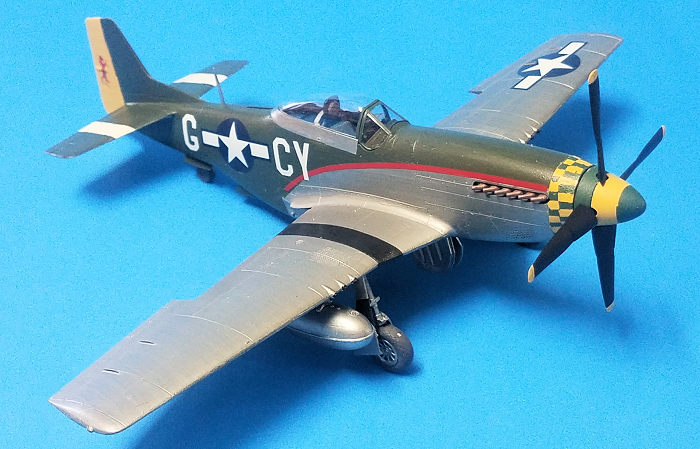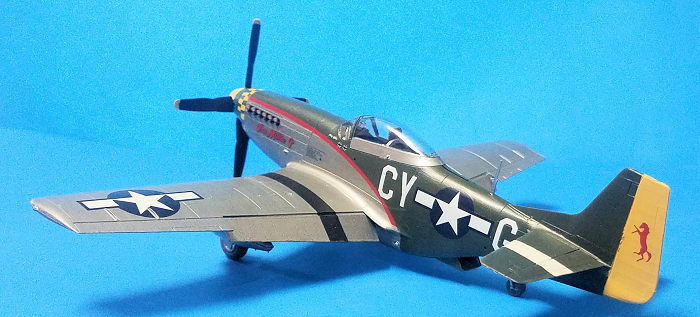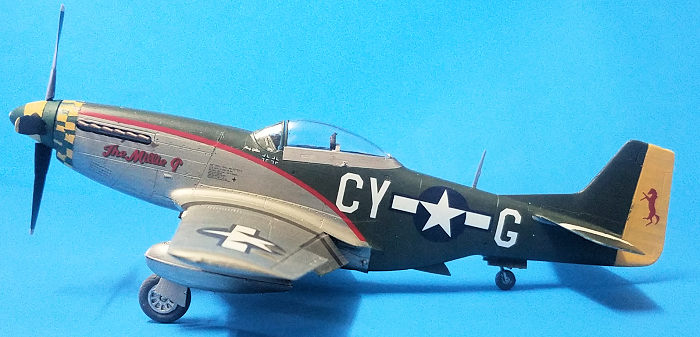
| KIT #: | 61040 |
| PRICE: | $25.00 |
| DECALS: | Four options |
| REVIEWER: | Francisco Santoro |
| NOTES: | Barracuda Decals BC48011 used |

| HISTORY |
"While Thunderbolt and Lightning adherents might hotly contest the claim, the Mustang has been rated as the best all-around United States fighter to serve in quantity in the Second World War. Operationally, all three fighters had formidable tallies and each was indispensable in its own sphere. Since each was so different in origins and technical features from the others, there seems no yardstick with which to compare them closely, but from the British viewpoint the Mustang stands out because it was built to conform to RAF requirements and because British technicians can modestly claim thereafter to have influenced its operational development to a considerable degree.
 At the turn of the year 1944/45, a new
Mustang variant was coming into service, though rather later than originally
planned. At the main North American plant at Inglewood, California, more drastic
improvements to visibility for the pilot had been planned than could possibly
have been made on active service. An unfinished P-51B airframe was taken from
the production line and rebuilt to accomodate a "teardrop" Typhoon type sliding
hood, resulting in changes to the rear fuselage structure and repositioning of
equipment. The new lowered rear decking lines were "moulded" into the main
fuselage contoursby again using the iconic lofting process, and the alterations
to the forward nose lines and windscreen originally envisaged were incorporated.
Armament alternatives were the usual four 50 caliber guns with 490 rounds apiece
or six 50 caliber wing guns with 270 rounds for the four outer weapons and 380
rounds for the two inner. The latter armament soon became standard, but because
of the extra weight and restressing underwing loads initially were restricted to
two 500 lbs bombs and two 75-gallon drop tanks or equivalents, a recommendation
often ignored in operational squadrons.
At the turn of the year 1944/45, a new
Mustang variant was coming into service, though rather later than originally
planned. At the main North American plant at Inglewood, California, more drastic
improvements to visibility for the pilot had been planned than could possibly
have been made on active service. An unfinished P-51B airframe was taken from
the production line and rebuilt to accomodate a "teardrop" Typhoon type sliding
hood, resulting in changes to the rear fuselage structure and repositioning of
equipment. The new lowered rear decking lines were "moulded" into the main
fuselage contoursby again using the iconic lofting process, and the alterations
to the forward nose lines and windscreen originally envisaged were incorporated.
Armament alternatives were the usual four 50 caliber guns with 490 rounds apiece
or six 50 caliber wing guns with 270 rounds for the four outer weapons and 380
rounds for the two inner. The latter armament soon became standard, but because
of the extra weight and restressing underwing loads initially were restricted to
two 500 lbs bombs and two 75-gallon drop tanks or equivalents, a recommendation
often ignored in operational squadrons.
Factory designations for the D series were NA-106, NA-109 and NA-122 from the Californian plant and NA-111 and NA-124 from production in Texas. From the former plant, 281 were supplied to the RAF as Mustang IVs serialled KH641-670, KM493-743; additionally and example (TK589) was sent for evaluation. This test aircraft delivered in June 1944 was in a finishing style then being used for operations against the V-bombs to obtain maximum speed-unpainted, with all joints filled in to provide a continuous smooth surface. From this time onwards, both in the Army Air Force and RAF, Mustangs were frequently to be seen in natural metal finish. Since it was a conspicuous finish, with speed replacing concealment as the Allies gained ascendancy in the air and camouflage no longer prime consideration, there ensued a spate of gaudy markings.
 Similar to the P-51D but built in Dallas
and fitted with an aeroproducts airscrew was the P-51K (NA-111), of these 597
were allocated to the RAF serialled KH944-947, KH671-870,KM100-492 and TK586 as
Mk IVAs.
Similar to the P-51D but built in Dallas
and fitted with an aeroproducts airscrew was the P-51K (NA-111), of these 597
were allocated to the RAF serialled KH944-947, KH671-870,KM100-492 and TK586 as
Mk IVAs.
The D-6 was a specialised tactical-reconnaissance version for the USAAF carrying oblique and vertical cameras in the rear fuselage while retaining full armament. The D-20 was the model supplies to Sweden in April 1945 as their J26. The D-10-NA and all Dallas D models introduced additional fin area in the form of a fillet between the aft decking and fin to increase directional stability throughout the speed range, as foreshadowed during the original Rolls Royce Merlin conversion trials in England. The fillet had not been necessary on the B and C versions, but the reduced side area at the rear on the D models no doubt influenced its eventual incorporation as a production item. Modification kits were distributed so that all Ds could be fitted with this fillet, but the decision was left to a large extent with local commanders.
Additional radio, including an MN-26C radio compass (fitted retrospectively to many machines), was also introduced at about the same time as the fin fillet, as well as attachment points for a cluster of three "bazooka" RP (rocket projectile) tubes beneath each wing."
| THE KIT |
 Inside the top opening box there're three
bags containing three sprues, two in dark grey plastic and a single clear sprue.
The clear sprue is separately bagged, and inside has two polycaps for the
propeller. The pieces have recessed panel lines.
Inside the top opening box there're three
bags containing three sprues, two in dark grey plastic and a single clear sprue.
The clear sprue is separately bagged, and inside has two polycaps for the
propeller. The pieces have recessed panel lines.
Instructions are of the foldable type, and have 10 steps in black and white.
There're a total of four decal options on this kit:
P-51D "Petie 2nd," John C. Meyer, 352nd FG, 487th FS.
P-51D "Nooky Booky IV," Leonard K. Carson, 357th FG, 362nd FS.
P-51D "Lou IV," Thomas J. Christian, 361st FG, 375th FS.
P-51D E2-S, Urban L. Drew, 361st FG, 375th FS.
| CONSTRUCTION |
 I began by painting the cockpit parts in
Interior Green (Revell 48). When dry, I picked up all the details of the cockpit
parts in black (such as the radio consoles behind the pilot's seat. The fuselage
sidewalls also received several coats of Interior Green with black details. Once
dry, I glued the cockpit to one fuselage half, and then glued the radiator
intake.
I began by painting the cockpit parts in
Interior Green (Revell 48). When dry, I picked up all the details of the cockpit
parts in black (such as the radio consoles behind the pilot's seat. The fuselage
sidewalls also received several coats of Interior Green with black details. Once
dry, I glued the cockpit to one fuselage half, and then glued the radiator
intake.
Wings came next. These are a single bottom and two tops parts. I first opened the holes for the underwing fuel tanks, and then the wings were glued together. It was at this point that I glued the fuselage and wings together. I also glued the non-faired exhausts (for "The Millie G" aircraft) and the engine cowling. These all fitted perfectly and required no filler anywhere. As a last step before painting, I glued the horizontal stabilizers. Finally, I glued the flaps in the down position.
| COLORS & MARKINGS |
I wanted to make the aircraft of Major
Edward Giller, "The Millie G." I began the painting stage by brushing the entire
aircraft with a light grey primer (Revell 76). Once dry, I painted from the
middle of the aircraft to the front a silver colour (Revell 91). Once the
metallic colour was dry, I masked the middle of the plane in a semicircular
fashion. This area would go in RAF Dark Green. Once painted RAF Dark Green (Revell
68), I painted the wings in the metallic colour, and once dry, I painted the
wing's bands in black, and the bands
 of the horizontal stabilizers in white.
Next, I painted the checkerboards of the nose in yellow (Revell 15), and then in
Revell 48 green (not the best looking checkerboards, but better than trusting
the decal). Once all that was painted, I brushed the entire model with two coats
of Revell's gloss varnish.
of the horizontal stabilizers in white.
Next, I painted the checkerboards of the nose in yellow (Revell 15), and then in
Revell 48 green (not the best looking checkerboards, but better than trusting
the decal). Once all that was painted, I brushed the entire model with two coats
of Revell's gloss varnish.
Barracuda decals are of excellent quality (printed by Cartograf), and moved from the backing paper after 10 seconds of dipping it in hot water. I began applying the decals from back to front, and finished after an hour of decalling. I made a mistake on the right side of the plane; I put the red band too low on the fuselage, with the consequence of the letters being placed above them. Once I had finished the decalling, I brushed the kit with two coats of Revell's matt varnish.
I painted the landing gear struts, doors and wheels. The former were painted in the fuselage metallic colour, and the latter were painted with Revell's Tank Grey 78 to simulate the tyres.
The final step was to paint the propeller. The blades were painted matt black with yellow tips, and the spinner was painted in green/yellow/green. I pushed the prop in place, and the model was finished.
| CONCLUSIONS |
Tamiya's P-51D is an absolute gem of a kit, its low parts count and good fit make if a perfect candidate for a weekend build. Even though the Eduard kit may be the new standard of the Mustang market, I'll still buy the Tamiya one.
| REFERENCES |
Classic Aircraft No.3 P-51 Mustang: Their history and how to model them by Roy Cross and Gerald Scarboroug
31 August 2020
Copyright ModelingMadness.com. If you would like your product reviewed fairly and
fairly quickly, please
contact
the editor
or see other details in the
Note to
Contributors.
Back to the Main Page
Back to the Review
Index Page
Back to the Previews Index Page